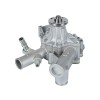In-transit truck insurance can be provided by a type of insurance known as an inland marine insurance policy. The purpose of inland marine insurance is to provide coverage for property that is being transported from one location to another. A policy can contain various coverage options for many types of property that is currently in transit. This type of insurance is usually purchased by businesses that need to insure property that is in the possession of a carrier during transport.
Insurable Property
Property that is in transit consists of personal property and real property. Personal property or property that can be moved is typically insured using an inland marine insurance policy for property that is in transit using a truck. This can include various types of equipment, furniture, clothing, machinery, and valuable papers and artwork.
Carriers
A carrier is defined as a person or entity that has possession of property that is being transported to another location. A carrier can use various methods of transport including railroad, waterway and trucks. There are various types of carriers including common carriers, contract carriers and private carriers. Carriers that transport property from state to state are subject to the Interstate Commerce Act.
Limitations of Liability
All inland marine insurance polices contain limitations to the liability coverage that is provided by the insurance policy. One type of limitation is for acts of god. This can include floods, tornadoes and other severe storms. Another liability limitation is an “exercise of public authority”. This can include police action or a quarantine by a representative of the government. In addition, a carrier cannot be held responsible for property with an “inherent vice” or the wear and tear of property from use.
Need for Coverage
Individuals or businesses that ship property may not always be covered for losses when damage occurs to the property during transit. This can be due to the financial ability of a carrier to pay for losses and any limitation on the value of the property. As a result property that is shipped may require annual transit insurance for property that is being transported. This type of insurance can be provided on an “all risk” or “named peril” basis. This means that risks are covered if not specifically excluded or named on a policy.
Limits of Insurance
An inland marine policy comes with various limits of insurance that are available depending on what is covered in the policy. This can include a limit on the type of transit being used, such as using a truck. A limit can also exist for property that is being transported in a vehicle. Another limitation on an inland marine insurance policy is a per occurrence or per disaster limit. This limitation states a maximum amount an insurer will pay based on the total amount of property being transported at any particular time.






